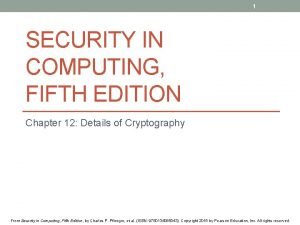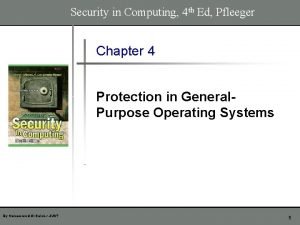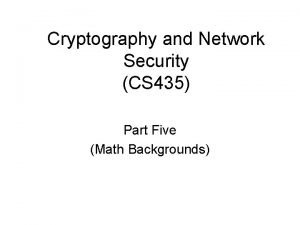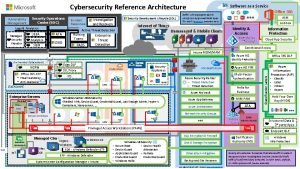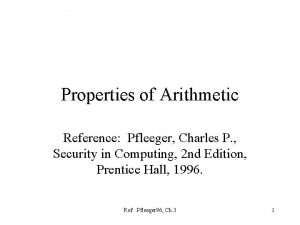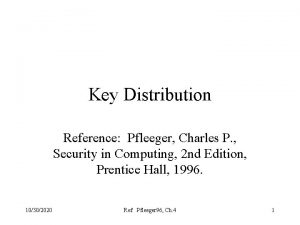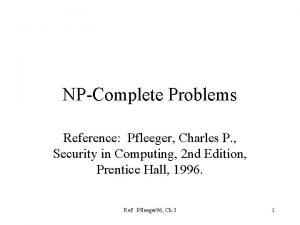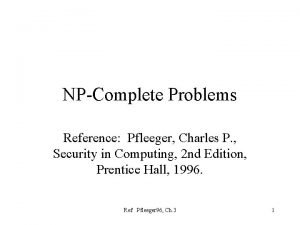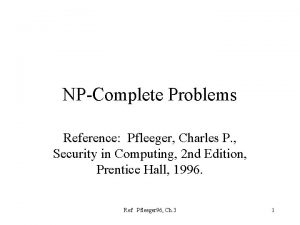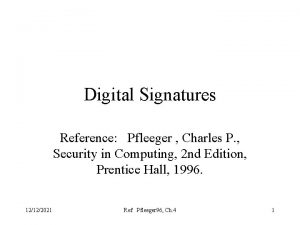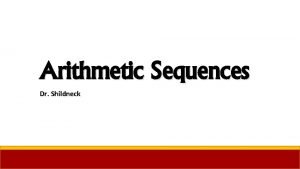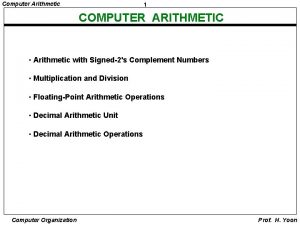Properties of Arithmetic Reference Pfleeger Charles P Security













- Slides: 13

Properties of Arithmetic Reference: Pfleeger, Charles P. , Security in Computing, 2 nd Edition, Prentice Hall, 1996. Ref: Pfleeger 96, Ch. 3 1

Identity and Inverses • Let “ ” denote an operation on numbers. • A number i is called an identity for operation “ ” if x i = x and i x = x for every number x. • The number b is called the inverse of a under “ ” if a b=i. Ref: Pfleeger 96, Ch. 3 2

Primes • A prime number is any positive number that is divisible (with remainder 0) only by itself and 1. • A number that is not a prime is a composite. Ref: Pfleeger 96, Ch. 3 3

Greatest Common Divisor • The greatest common divisor of two integers, a and b, is the largest integer that evenly divides both a and b. • Examples – gcd(10, 15) = 5 – If p and q are primes, then gcd(p, q) = 1. Ref: Pfleeger 96, Ch. 3 4

Euclidean Algorithm • Algorithm for finding the greatest common divisor , x of integers a and b. • Suppose a>b. • Then a = m*b +r, where m=a/b with remainder r. • If x=gcd(a, b) then x divides into a, m*b, and r. Ref: Pfleeger 96, Ch. 3 5

Euclidean Algorithm (p. 2) • But gcd(a, b) = gcd(b, r). • Then b = m’*r +r’, where m’ = b/r with remainder r’. • This process continues, until the remainder is 0. Ref: Pfleeger 96, Ch. 3 6

Euclidean Algorithm (p. 3) • Example: Find gcd(105, 45). – 105 = 2*45 + 15 – 45 = 3*15 + 0 – gcd(105, 45) = 15 Ref: Pfleeger 96, Ch. 3 7

Modular Arithmetic • Modular arithmetic on nonnegative integers forms a commutative ring with operations addition and multiplication. • If every number other than 0 has an inverse under multiplication, the group is a Galois field. • The integers mod n are a Galois Field Ref: Pfleeger 96, Ch. 3 8

Properties of Modular Arithmetic • Associativity – a +(b+c) mod n =(a+b)+c mod n – a *(b*c) mod n =(a*b)*c mod n • Commutativity – a+b mod n = b+a mod n – a*b mod n = b*a mod n Ref: Pfleeger 96, Ch. 3 9

Properties of Modular Arithmetic (p. 2) • Distributivity – a*(b+c) mod n = ((a*b) + (a*c)) mod n • Existence of Identities – a+0 mod n = 0+a mod n = a – a*1 mod n = 1*a mod n = a Ref: Pfleeger 96, Ch. 3 10

Properties of Modular Arithmetic (p. 3) • Existence of Inverses – a + (-a) mod n =0 – a*(a-1) mod n = 1 if a 0 • Reducibility – (a+b) mod n = ((a mod n) + (b mod n)) mod n – (a*b) mod n = ((a mod n) * (b mod n)) mod n Ref: Pfleeger 96, Ch. 3 11

Fermat’s Theorem • Let p be a prime and let a be an element such that a<p. • Then ap mod p = a or ap-1 mod p = 1. Ref: Pfleeger 96, Ch. 3 12

Computing Inverses • Let p be a prime and a < p. • Let x be the inverse of a. • Then ax mod p =1 (definition of inverse) ap-1 mod p =1 (Fermat’s Theorem) ax mod p = ap-1 mod p x mod p = ap-2 mod p Ref: Pfleeger 96, Ch. 3 13
 Security in computing 5th edition ppt chapter 2
Security in computing 5th edition ppt chapter 2 Security in computing pfleeger
Security in computing pfleeger Private secuirty
Private secuirty Charles manson childhood
Charles manson childhood Gcd(1970,1066)
Gcd(1970,1066) Reference node and non reference node
Reference node and non reference node Reference node and non reference node
Reference node and non reference node Nist architecture in cloud computing
Nist architecture in cloud computing Microsoft cybersecurity reference architecture
Microsoft cybersecurity reference architecture Extensive and intensive examples
Extensive and intensive examples Chemical and physical properties
Chemical and physical properties Osi security architecture with neat diagram
Osi security architecture with neat diagram Security guide to network security fundamentals
Security guide to network security fundamentals Wireless security in cryptography
Wireless security in cryptography
